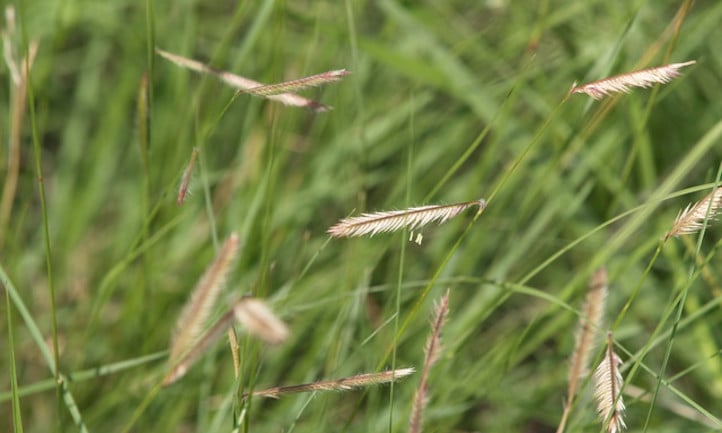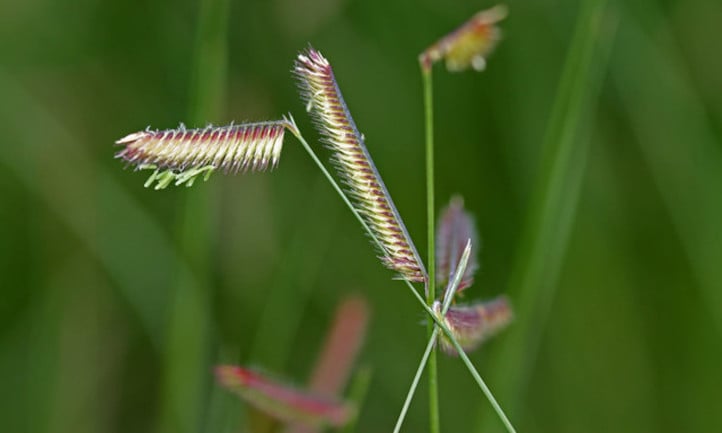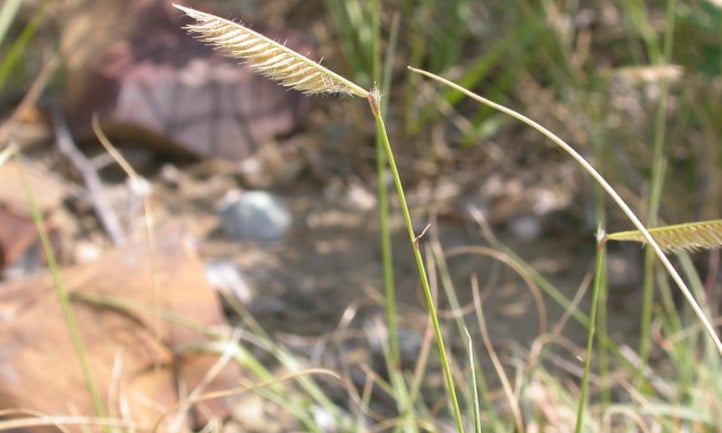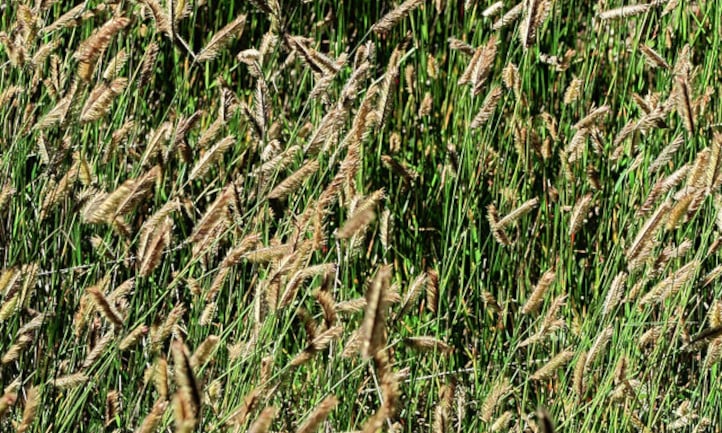Do it’s a must to’re looking for a yard completely totally different that helps wildlife, look no further than blue grama grass (Bouteloua gracilis)! It’s generally as in contrast with buffalograss and will even be interplanted with buffalograss to create a pure yard of native vegetation.
In distinction to buffalograss, it tends to remain clumpy, considerably if water ranges are low, and it doesn’t unfold as rapidly. As a plant of perennial origin, it does correctly all by heat seasons, considerably in its native habitat. When left to develop to full maturity, it produces flowers that cling on the ideas of the blades and resemble eyelashes.
The flowers of those grass vegetation produce seeds that may propagate much more blue grama grass. Furthermore they act as a meals present for birds and completely totally different small animals. Like completely totally different grass vegetation of its choice, blue grama spreads through the yard by way of underground short-term rhizomes, though slowly.
When grown as decorative grasses, grama vegetation can add seen curiosity to your panorama by creating distinction amongst the flowers in your yard, making a natural-looking wildflower meadow. These water-wise, native vegetation are furthermore the larval host plant for skippers, butterflies, and moths. The flower and leaf enchantment to grownup species that lay eggs on the leaf blades of the plant.
Fast Care Data


| Frequent Set up | Blue grama grass, mosquito grass |
| Scientific Set up | Bouteloua gracilis |
| Household | Poaceae |
| Prime & Unfold | 30-36 inches tall and large |
| Mild | Full picture voltaic |
| Soil | Tolerates quite a few soil sorts |
| Water | Low water, drought resistant |
| Pests & Sicknesses | Grasshoppers, rust fungus |
All About Blue Grama Grass


The Bouteloua gracilis (blue grama grass) plant is usually present in elements of Western Canada and south all by the Rocky Mountains, Good Plains, Colorado Springs, and a few Midwest states into Mexico. It’s thought-about thought-about certainly one of many Big 4 native grasses in Texas all the way in which by which all the way in which all the way down to Mexico, and it’s Colorado’s state grass!
It is usually generally generally called mosquito grass on account of the seed pods have been mentioned to resemble mosquitoes floating above the blades. It’s perennial in origin, which suggests you will add these vegetation to your panorama or yard and luxuriate in them for years to return with little or no effort.
Blue grama grass has slim leaf blades which might be about 6 inches of their fully mature selection and generally curl, with leaf margins that roll inwards. They’re a beautiful sight to see on the plains blended with completely totally different native vegetation. Their flower heads selection from flowers that seem on one facet of the stems and look considerably like a single chook’s wing. This one facet is the place the seed is swept all by the plains for propagation.
This heat season grass loves full picture voltaic. It would properly survive quite a few soils, together with sandy soils. When these native vegetation are utilized in a yard, they will stand as a lot as mowing to a peak of three inches and may be saved as low-growing grass vegetation. Do it’s a must to want to keep up them inexperienced, be sure that to water all of them by occasions of most drought. Blue grama vegetation will naturally flip brown after they go dormant all through the winter.
Blue Grama Grass Care
Blue grama grass is definitely thought-about certainly one of many decorative grasses native to the good plains. When grown in its native habitat, it’s low repairs and drought-resistant.
Photograph voltaic and Temperature for These Native Crops
Blue grama vegetation develop largest in full picture voltaic, with a minimal of 6 to eight hours of daylight per day. They do largest in USDA rising zones 5-9. Blue grama’s perennial origin signifies that it will go dormant all through the wintertime and could be discovered as soon as extra with new progress all through the spring. When planting from seed, it’s largest to attend till the autumn so the seed can chilly stratify over the chilly seasons. This heat-loving native grass requires heat temperatures of spring with the intention to help germination.
Most likely primarily essentially the most energetic interval of the rising season happens when temperatures are between 70-90 ranges Fahrenheit. Along with being warmth tolerant, it’s furthermore chilly tolerant. Progress will sluggish on account of the nighttime temperatures start to drop all through the autumn, and eventually, all through the winter, it can flip tawny, nonetheless it can not at all completely die as soon as extra. Though blue grama grass is native to western Colorado, it does have an elevation prohibit on the hardiness of 7500 ft.
Native Grass Water and Humidity
Since blue grama grass loves the entire picture voltaic and heat temperatures, do your watering all through the morning earlier than the warmth of the day. This vogue, the water might have the flexibleness to penetrate to the roots earlier than the picture voltaic has a chance to evaporate the moisture. As your native grasses flip into established, their watering needs will change.
Of their first yr of progress, they must be watered a minimal of two occasions per week in the midst of the rising season. Of their second yr, this may be diminished to 1 time per week. Of their third yr, this may be further diminished to 1 time each 1-2 weeks. All through the wintertime, snowfall should present ample moisture, nonetheless in significantly dry winters, they’re sometimes watered as rapidly as a month so long as air and soil temperatures are above 40 ranges and the soil merely shouldn’t be frozen.
As rapidly as your blue grama grass has reached maturity, then they flip into terribly drought resistant and will survive on as little as 7 inches of annual rain. All by prolonged dry spells – even all through the warmth of summer season season –inside the event that they aren’t irrigated, they go dormant and might flip brown nonetheless will spring as soon as extra to life on the first signal of moisture. Do it’s a must to want to keep up your grama grass inexperienced, then it’s possible you’ll select to water all of it by these durations.
Soil


This bunch grass is understood for tolerating numerous soil sorts. Blue grama grows naturally in dry prairies and is usually present in rocky or clay soil. It does largest, nonetheless, with well-draining soil. It isn’t present in moist, poorly drained soils and may be broken by overwatering or soggy/waterlogged soil circumstances. For that goal, it doesn’t tolerate being planted in areas with a excessive water desk.
Blue grama grass furthermore prefers impartial soil and will’t address acidic circumstances. Do it’s a must to’re planting in a terribly wealthy medium, add ample parts of sand to assist with drainage. Optimistic sandy soils are merely giant for this grass.
Fertilizing
Actually certainly one of many advantages of rising blue grama grass is that it’s very low repairs. It would properly survive on little or no water, can tolerate each sort of soil sorts, and doesn’t require any widespread fertilizer or soil amendments. Though fertilizing isn’t necessary, it could possibly be considerably useful everytime you’re utilizing it as a neighborhood completely totally different and have to keep up its inexperienced coloration. Fertilize with nitrogen yearly in June. When beginning blue grama grass from seed, it’d in all probability income from the rise of a layer of compost on the planting web site on-line, though this isn’t a must.
Pruning
To know the pruning necessities for blue grama grass, you’ll have to first perceive its pure progress habits. By means of the energetic rising season from mid-May to October, the blades is probably mild inexperienced in coloration. All by late summer season season, the seed heads will selection (when grown as a decorative and left unmowed). By means of the winter, it can go dormant and swap mild brown in coloration. It could be left standing so as in order so as to add curiosity to your winter panorama. Then in February, it’d in all probability address mowing to a peak of three inches and would possibly then positioned on new progress all through the spring.
When used as a yard completely totally different, it’d in all probability address being sometimes mowed to a peak of three inches, or it could possibly be left to develop a bit taller for an additional pure yard look. This native grass can tolerate heavy foot visitors, so it’s maybe giant in an home that children and pets frequent. As winter approaches, let your grass acquire some peak to direct vitality within the path of the muse system. It will brown in the midst of the winter nonetheless will come as soon as extra to life all through the spring.
Blue Grama Propagation
Like most grasses, the blue grama grass species is principally propagated by seeds. Which may be very true when utilizing this plant as a yard completely totally different which could require you to broadcast seeds all by a large home. There are native seed corporations that promote seeds of wildflowers and native grasses blended collectively. To plant them, broadcast the seeds over an home all through the autumn after which cowl them evenly with an unimaginable layer of sandy or silty provides to deal with them from blowing away all through the wind. Then water them in and water as rapidly as each two weeks to assist them germinate.
Which may be lots simpler than transplanting bunches as they’re sluggish rising and take their time spreading. Rising from transplants is the best technique of propagation when utilizing Bouteloua gracilis as a decorative grass. You then get the advantage of a really established plant in your panorama moderately lots sooner. You would possibly as properly plant plugs of grass blended with species of native wildflowers.
Troubleshooting Blue Grama Grass


As talked about above, blue grama grass is usually pest and illness free! There are, nonetheless, some factors to be looking for.
Grama Grass Rising Factors
Most rising factors happen when this plant is overwatered. If the underside feels spongy, you uncover standing water, or in case your grass is unexpectedly wilting, that is maybe an indication you’re overwatering. This plant is awfully drought tolerant, and it’s elevated to water lots a lot much less pretty than overwater. It would properly bounce as soon as extra and thrive on little or no moisture. Nonetheless, an excessive amount of moisture would possibly set off harm.
Pests
Grasshopper species have been acknowledged to chomp on the leaf of blue grama grasses, nonetheless on the complete, their feeding isn’t satisfactory to set off important harm to the plant. Normally, the grasshopper inhabitants is definitely managed by your neighborhood birds and completely totally different small wildlife.
Sicknesses
Most likely primarily essentially the most prevalent illness matter with this grass is fungal rust which, as its title would counsel, is attributable to a fungus. One signal of rust fungus is small reddish-orange spots on the leaves. This fungus prefers heat, moist, and humid environments. Watering solely in excessive drought and solely when the clumps of grass have a chance to dry all through the good a part of the day may also help keep away from these elements.
Neem oil or a copper fungicide may also help administration rust utilized to the foliage may also help administration rust on the grass. Cautious making use of these in native habitat restoration duties and pollinator gardens, as they’re sometimes harmful to pollinators.
Incessantly Requested Questions


Q: Does blue grama grass unfold?
A: It does unfold by way of underground roots which might be short-term rhizomes. Nonetheless, it tends to develop in clumps, considerably in hotter climates.
Q: What does blue grama grass do?
A: It’s a warm-season grass that could be utilized as an ornamental grass or native completely totally different that survives on low ranges of summer season season precipitation. When left to develop to its full peak, it can put out a flower contained in the sort of horizontal blossom clusters that resemble eyelashes.
Q: Do you inside the low cost of blue grama grass?
A: When used as a neighborhood completely totally different, it’d in all probability survive mowing to a peak of three inches. When used as a decorative grass, it could possibly be left to develop to its full peak after which inside the low cost of in February appropriate earlier than it begins to positioned on new progress all through the spring.
Q: How extended does it take blue grama to develop?
A: This low-growing grass is understood to unfold slowly. As a perennial, it can slowly unfold yr after yr, relying on the rising circumstances.
Q: What animals eat blue grama grass?
A: This grass is usually used as forage for livestock akin to sheep and cattle. It furthermore attracts seed-eating birds and is the larval host plant for skippers, butterflies, and moths.
Q: Is blue grama deer resistant?
A: Sure, it’s deer-resistant, nonetheless it’s beloved by elk and bison.
Q: Is blue grama grass salt tolerant?
A: It’s pretty tolerant to salt.
Q: How do you harvest blue grama grass seed?
A: Wait till the seed pods have reached full maturity after the autumn flower has pale. They need to truly actually really feel onerous and dry to the contact. The pods must interrupt open merely in your hand, revealing the seed.